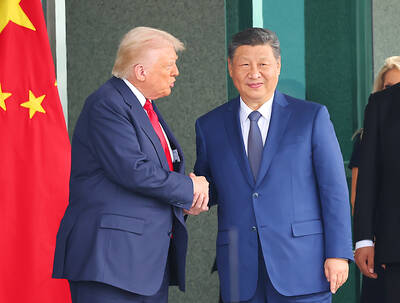The nation’s consumer price index (CPI) rose 2 percent last month from a year earlier as cold weather continued to drive up food costs, with vegetable and fruit prices staying at a 21-year high, the Directorate-General of Budget, Accounting and Statistics (DGBAS) said yesterday.
It is the second consecutive month the inflationary gauge has hit the 2 percent level, but the statistics agency dismissed concerns, saying the phenomenon would prove to short-lived once weather disruptions fade.
“Last month saw little correction in vegetable prices due to lingering supply disruptions, even though holiday demand subsided,” DGBAS Deputy Director Tsai Yu-tai (蔡鈺泰) told a news conference.
Vegetable prices surged 79.1 percent year-on-year last month, little changed from an 81 percent increase in February, as humid weather and inadequate sunlight thwarted supply, Tsai said.
Likewise, fruit prices recorded an 18.99 percent increase last month, the DGBAS report said, adding that together, the two items raised the CPI reading by 2 percentage points.
Food costs, which account for 25 percent of the index, climbed 8.62 percent last month, rising at the fastest pace in 43 months with contributions also from fishery products, processed food and dining costs, the report said.
The inflationary measure fell 0.18 percent last month after seasonal adjustments, affirming a very limited change, the report said.
Core CPI, a more reliable gauge to monitor long-term price movements because it excludes volatile items, printed a 0.79 increase last month, lending support to benign inflation, Tsai said.
For the first quarter, the CPI picked up 1.74 percent, faster than the agency’s forecast in February at 1.24 percent, the report said, suggesting higher general living costs amid a poor economy.
The cost burden comes despite crude oil prices declining 13.22 percent year-on-year last month, dragging transportation and communication costs by 2.59 percent, the report said.
The wholesale price index — a measure of production costs — fell 4.94 last month, stable from a revised 4.92 percent decline in February, the report said, as the world is ready to closely watch a meeting of oil-producing countries on April 17.
Cheaper oil helped sink export prices by 7.26 percent last month in US dollar terms, meaning an equal volume of shipments would cost less this year, the report said.
That is unfavorable for exports, Minister of Finance Chang Sheng-ford (張盛和) said, as it indicated Taiwan might have continued to contract by double percentage digits last month.
A higher CPI would allow the central bank less leeway for monetary easing, as the policymaker is widely predicted to be cutting interest rates by another 12.5 basis points in June to support GDP growth.

RUN IT BACK: A succesful first project working with hyperscalers to design chips encouraged MediaTek to start a second project, aiming to hit stride in 2028 MediaTek Inc (聯發科), the world’s biggest smartphone chip supplier, yesterday said it is engaging a second hyperscaler to help design artificial intelligence (AI) accelerators used in data centers following a similar project expected to generate revenue streams soon. The first AI accelerator project is to bring in US$1 billion revenue next year and several billion US dollars more in 2027, MediaTek chief executive officer Rick Tsai (蔡力行) told a virtual investor conference yesterday. The second AI accelerator project is expected to contribute to revenue beginning in 2028, Tsai said. MediaTek yesterday raised its revenue forecast for the global AI accelerator used

Taiwan Semiconductor Manufacturing Co (TSMC, 台積電) has secured three construction permits for its plan to build a state-of-the-art A14 wafer fab in Taichung, and is likely to start construction soon, the Central Taiwan Science Park Bureau said yesterday. Speaking with CNA, Wang Chun-chieh (王俊傑), deputy director general of the science park bureau, said the world’s largest contract chipmaker has received three construction permits — one to build a fab to roll out sophisticated chips, another to build a central utility plant to provide water and electricity for the facility and the other to build three office buildings. With the three permits, TSMC

TEMPORARY TRUCE: China has made concessions to ease rare earth trade controls, among others, while Washington holds fire on a 100% tariff on all Chinese goods China is effectively suspending implementation of additional export controls on rare earth metals and terminating investigations targeting US companies in the semiconductor supply chain, the White House announced. The White House on Saturday issued a fact sheet outlining some details of the trade pact agreed to earlier in the week by US President Donald Trump and Chinese President Xi Jinping (習近平) that aimed to ease tensions between the world’s two largest economies. Under the deal, China is to issue general licenses valid for exports of rare earths, gallium, germanium, antimony and graphite “for the benefit of US end users and their suppliers

Dutch chipmaker Nexperia BV’s China unit yesterday said that it had established sufficient inventories of finished goods and works-in-progress, and that its supply chain remained secure and stable after its parent halted wafer supplies. The Dutch company suspended supplies of wafers to its Chinese assembly plant a week ago, calling it “a direct consequence of the local management’s recent failure to comply with the agreed contractual payment terms,” Reuters reported on Friday last week. Its China unit called Nexperia’s suspension “unilateral” and “extremely irresponsible,” adding that the Dutch parent’s claim about contractual payment was “misleading and highly deceptive,” according to a statement